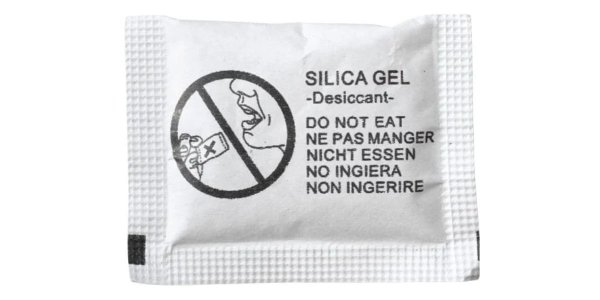The surprising reason “Do Not Eat” packets are in almost everything you buy!
- Replies 0
You've just unboxed your latest gadget, a pair of sleek new shoes, or perhaps a bottle of your favorite vitamins. Amidst the excitement, you spot a familiar tiny packet nestled among your new treasures, emblazoned with a stark warning: “Do Not Eat.”
These packets are as abundant as the products they protect, but their presence is far from arbitrary. Let's unravel the mystery behind these small but mighty guardians of your goods.
These packets are filled with desiccants, substances specifically designed to combat moisture.
Silica gel, the star player among desiccants, is a form of silicon dioxide that can absorb up to 40 percent of its weight in water. These tiny silica beads work tirelessly, drawing in moisture from the air and locking it away.
This process keeps your products dry and safe from the clutches of humidity. Moisture might seem harmless, but it's a veritable villain when it comes to the integrity of many products.

Electronics, for instance, are precision-engineered to function optimally in dry conditions. Humidity can wreak havoc on their delicate internal components, leading to corrosion, short-circuiting, and ultimately, failure.
Similarly, leather goods, clothing, and even some foods can fall prey to mold, mildew, and degradation if left unprotected. The silica gel packets act as miniature dehumidifiers, ensuring that the environment within the packaging remains arid and hostile to moisture.
The warning label on these packets might pique your curiosity or even tempt you to rebel against the directive. However, it's there for good reason.
While silica gel itself is non-toxic, it can be a choking hazard, especially if the beads are released from the packet. Additionally, some desiccant packets may contain other chemicals that could be harmful if ingested.
In the event that someone does consume the contents, it's crucial to seek medical advice immediately, even though the silica is likely to pass through the digestive system without causing harm.
The presence of these packets in your home should be handled with care, particularly if you have young children or pets.
To them, anything can seem like a potential snack, and the consequences of ingestion can be serious. It's best to dispose of these packets promptly and ensure they're out of reach to prevent any accidental consumption.
Given the potential risks, there's a growing conversation about the design of these packets. Should they be made to look less like condiment sachets and more like something you'd never dream of eating?
Until such changes are implemented, it's up to us as consumers to stay vigilant and heed the warnings.

Have you ever wondered about the purpose of these “Do Not Eat” packets? Do you have any tips for safely disposing of them or keeping them away from curious pets and children? Share your thoughts and experiences in the comments below!
These packets are as abundant as the products they protect, but their presence is far from arbitrary. Let's unravel the mystery behind these small but mighty guardians of your goods.
These packets are filled with desiccants, substances specifically designed to combat moisture.
Silica gel, the star player among desiccants, is a form of silicon dioxide that can absorb up to 40 percent of its weight in water. These tiny silica beads work tirelessly, drawing in moisture from the air and locking it away.
This process keeps your products dry and safe from the clutches of humidity. Moisture might seem harmless, but it's a veritable villain when it comes to the integrity of many products.

Silica gel packets are commonly used as desiccants in product packaging to absorb moisture and protect the goods from moisture damage. Image source: @v47093 via Reddit.
Electronics, for instance, are precision-engineered to function optimally in dry conditions. Humidity can wreak havoc on their delicate internal components, leading to corrosion, short-circuiting, and ultimately, failure.
Similarly, leather goods, clothing, and even some foods can fall prey to mold, mildew, and degradation if left unprotected. The silica gel packets act as miniature dehumidifiers, ensuring that the environment within the packaging remains arid and hostile to moisture.
The warning label on these packets might pique your curiosity or even tempt you to rebel against the directive. However, it's there for good reason.
While silica gel itself is non-toxic, it can be a choking hazard, especially if the beads are released from the packet. Additionally, some desiccant packets may contain other chemicals that could be harmful if ingested.
In the event that someone does consume the contents, it's crucial to seek medical advice immediately, even though the silica is likely to pass through the digestive system without causing harm.
The presence of these packets in your home should be handled with care, particularly if you have young children or pets.
To them, anything can seem like a potential snack, and the consequences of ingestion can be serious. It's best to dispose of these packets promptly and ensure they're out of reach to prevent any accidental consumption.
Given the potential risks, there's a growing conversation about the design of these packets. Should they be made to look less like condiment sachets and more like something you'd never dream of eating?
Until such changes are implemented, it's up to us as consumers to stay vigilant and heed the warnings.
Key Takeaways
- Silica gel packets are commonly used as desiccants in product packaging to absorb moisture and protect the goods from moisture damage.
- These packets contain silica pellets which can absorb up to 40 percent of their weight in water, acting as miniature dehumidifiers.
- Consumers are warned not to eat the contents of these packets as they can present a choking hazard and may contain harmful chemicals other than silica.
- The warning labels serve to prevent ingestion by children or pets and to alert consumers of potential health risks, despite silica itself not being toxic.
Have you ever wondered about the purpose of these “Do Not Eat” packets? Do you have any tips for safely disposing of them or keeping them away from curious pets and children? Share your thoughts and experiences in the comments below!






